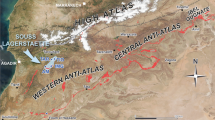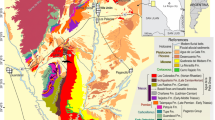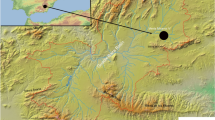Abstract
The Robertson Bay Group is a thick (>3,000 m) sequence of turbidites deposited in one or more submarine-fan complexes1–3. It is exposed throughout the eastern half of North Victoria Land and has been assigned variously to the Upper Precambrian4 (on the basis of acritarchs and lack of body fossils), or to the Lower Cambrian5 or Cambrian2 (partly on the basis of trace fossils). We report here Upper Cambrian and Lower Ordovician conodonts in a limestone block within rocks mapped3,6 as Robertson Bay Group in the southeastern part of North Victoria Land. This discovery necessitates a reappraisal of tectonic reconstructions of the pre-Mesozoic units of southeast Australia, New Zealand and Antarctica7–17. A reconstruction is proposed which includes correlation of the Lower Ordovician Greenland Group, New Zealand and the Upper Cambrian–Lower Ordovician Wierah Formation of southern Tasmania.
This is a preview of subscription content, access via your institution
Access options
Subscribe to this journal
Receive 51 print issues and online access
$199.00 per year
only $3.90 per issue
Buy this article
- Purchase on Springer Link
- Instant access to full article PDF
Prices may be subject to local taxes which are calculated during checkout
Similar content being viewed by others
References
Wright, T. Geol. Jb. B41, 127–138 (1981).
Field, B. & Findlay, R. in Antarctic Earth Science (ed. Oliver, R.) 123–126 (Australian Academy of Science, Canberra, 1983).
Tessensohn, F., Duphorn, K., Jordan, H., Kleinschmidt, G., Skinner, D., Vetter, U., Wright, T. & Wyborn, D. Geol. Jb. B41, 31–88 (1981).
Laird, M. & Bradshaw, J. N.Z. Antarct. Rec. 4(2), 3–10 (1982).
Cooper, R., Jago, J., McKinnon, D., Shergold, J. & Vidal, G. in Antarctic Geoscience (ed. Craddock, C.) 629–633 (University of Wisconsin Press, Madison, 1982).
Le Couteur, P. & Leitch, E. in Antarctic Geology (ed. Adie, R.) 229–236 (North-Holland, Amsterdam, 1964).
Cooper, R. N.Z. Jl Geol. Geophys. 18, 1–20 (1975).
Griffiths, J. Nature 234, 203–207 (1971); 249, 336–338 (1974); Bull. geol. Soc. Am. 88, 1203–1210 (1977).
Laird, M., Cooper, R. & Jago, J. Nature 265, 107–110 (1977).
Cooper, R. J. R. Soc. New Zealand 9, 29–84 (1979).
Harrington, H. Nature 245, 109–112 (1973).
Solomon, M. & Griffiths, J. in The Tasman Geosyncline, 19–46 (University of Queensland Press, Brisbane, 1974).
Grindley, G. & Davey, F. in Antarctic Geoscience (ed. Craddock, C.) 15–29 (University of Wisconsin Press, Madison, 1982).
Cooper, R. & Grindley, G. (eds) Late Proterozoic–Devonian sequences of S.E. Australia, Antarctica and New Zealand and their correlation (Geological Society of Australia, Sydney, 1982).
Jago, J. in Gondwana Five (eds Creswell, M. & Vella, P.) 199–204 (Balkema, Rotterdam, 1981).
Laird, M. J. R. Soc. N.Z. 11, 425–438 (1982).
Quilty, P. in Antarctic Symposium 18–40 (Anzaas, Hobart, 1981).
Kleinschmidt, G. & Skinner, D. Geol. Jb. B41, 155–199.
Findlay, R. & Field, B. in Antarctic Earth Science (ed. Oliver, R.) 107–112 (Australian Academy Science, Canberra, 1983).
Miller, J. Paleontol. Contr. Univ. Kans. 99, 1–44 (1980).
Fortey, R., Landing, E. & Skevington, D. in Cambrian-Ordovician boundary (eds Bassett, M. & Dean, W.) 95–129 (National Museum of Wales, Cardiff, 1982).
Moore, R. Treatise on Invertebrate Paleontology Part O Arthropoda 1. (University of Kansas Press, Lawrence, 1959).
Adams, C., Gabites, J., Wodzicki, A., Laird, M., Bradshaw, J. in Antarctic Geoscience (ed. Craddock, C.) 543–554 (University of Wisconsin Press, Madison, 1982).
Ross, R., Naeser, C. & Lambert, R. Am. Ass. petrol. geol. Stud. 6, 347–354 (1978).
Williams, E. Tectonophysics 48, 159–205 (1978).
Spry, A. & Banks, M. (eds) Geology of Tasmania (Geological Society Australia, Adelaide, 1962).
Berry, R. & Harley, S., Pap. Proc. R. Soc. Tasmania 117, 59–76 (1983).
Burrett, C., Stait, B. & Laurie, J. Mem. Ass. Australas. Palaeont. 1, 177–193 (1983). Geol. Soc. Aust. Abstr. 9, 198–199 (1983).
Burrett, C., Stait, B., Sharples, C. & Laurie, J. in Handbook of the Ordovician System (eds Bruton, D. & Williams, S.) (Universitetsforlaget, Oslo, in the press).
Wyborn, D. Bur. Min. Resour. Geol. Geophs. Yb. 81, 12–16 (1982).
Laird, M. N.Z. Jl Geol. Geophys. 15, 372–393 (1972).
Douglas, J. & Ferguson, J. Geology of Victoria (Geological Society of Australia, Melbourne, 1976).
Author information
Authors and Affiliations
Rights and permissions
About this article
Cite this article
Burrett, C., Findlay, R. Cambrian and Ordovician conodonts from the Robertson Bay Group, Antarctica and their tectonic significane. Nature 307, 723–725 (1984). https://doi.org/10.1038/307723a0
Received:
Accepted:
Issue Date:
DOI: https://doi.org/10.1038/307723a0
This article is cited by
Comments
By submitting a comment you agree to abide by our Terms and Community Guidelines. If you find something abusive or that does not comply with our terms or guidelines please flag it as inappropriate.



